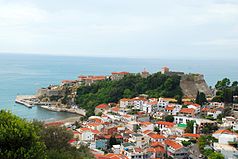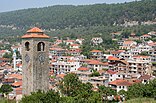Ulcinj
Ulcinj
Улцињ Ulqin | |
|---|---|
Town and municipality | |
From the top, View over the city, Pasha Mosque, The Clocktower | |
|
UTC+2 (CEST) | |
| Postal code | 85360 |
| Area code | +382 30 |
| ISO 3166-2 code | ME-20 |
| Car plates | UL |
| Website | Official Website |
Ulcinj (Cyrillic: Улцињ, pronounced [ǔlt͡siɲ]; Albanian: Ulqin or Ulqini; Italian: Dulcigno) is a town on the southern coast of Montenegro and the capital of Ulcinj Municipality.[1] It has an urban population of 10,707 (2011), the majority being Albanians.[2]
As one of the oldest settlements in the Adriatic coast, it was founded in 5th century BC. It was captured by the Romans in 163 BC from the Illyrians. With the division of the Roman Empire, it was a part of the Byzantine Empire and Serbian Kingdom in the Middle Ages until the Republic of Venice captured it in 1405.[3] It was known as a base for piracy.[4]
In 1571, Ulcinj was conquered by the
Ulcinj remained an Ottoman town for more than 300 years until it was ceded to the Principality of Montenegro in 1878.[7] It is a former medieval Catholic bishopric and remains a Latin titular see.[8]
Ulcinj is a destination for tourists, because of its Long Beach, Lake Šas, Ada Bojana Island and for its two-millennia-old Ulcinj Castle.[9] There are 26 mosques in the town and surrounding countryside.[10] Ulcinj is the centre of the Albanian community in Montenegro.[11]
Names
Early historian
Geography
Neighbourhoods
- Çarshia (mn. Čaršija), is a mosques located in this area, the Namazgjahu Mosque and Kryepazari Mosque.
History
Antiquity
Ulcinj is an ancient seaport.
All the way in the pre-medieval period, Ulcinj was known as one of the pirate capitals of the
Roman

In 168 BC, during the
The Periplus Maris Erythraei names several Indian ports from where large ships sailed in an easterly direction to Khruse (Kruče - seaside village in Ulcinj).[19]
After the division of the Roman Empire, Ulcinj became a part of the Byzantine province of
Medieval period
In the 9th century, it was in the
By 1040, archon
Venetian and Ottoman rule
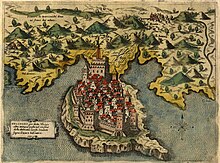
In 1405 the Venetians conquered the town. Under Venetian control, the city was renamed Dulcigno in
In the 17th century a self-proclaimed Jewish
During the 19th century, the town began to regain its position as a flourishing port. The geographer
In 1867, Ulcinj became a
In May 1880, the Great Powers (Britain, France, Germany, Austria-Hungary, Italy, and Russia) protested diplomatically and organized a naval demonstration off the coast of Dulcigno to put pressure on the Ottoman Empire to resolve the dispute peacefully. The Ottoman Empire eventually agreed to cede the town and surrounding territory to Montenegro in exchange for compensation.
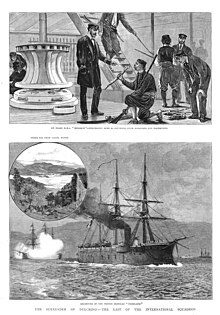
The surrender of Dulcigno to Montenegro marked a significant expansion of Montenegro's territory and was seen as a diplomatic victory for the Great Powers, who had prevented a potentially violent conflict in the region.[citation needed]
After the city's annexation to Montenegro, of its 8,000-strong population about 3,000 Albanians left and settled elsewhere in northern Albania. 142 Montenegrin families were brought to settle in the outskirts of Ulcinj in the 1880s. The population of Ulcinj steadily decreased until the post-WWII period.[21]
20th century to present
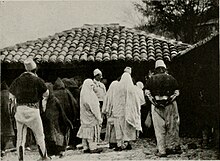
Ulcinj became a part of the Kingdom of Montenegro from 1878 until 1918 when Montenegro was absorbed into the Kingdom of Serbia for a short time before all would be incorporated into the first of the Yugoslav federations at the end of the year. Ulcinj remained within a Montenegrin entity whilst a South Slavic state had existed until 2006 when which it became part of an independent Montenegro following a referendum.
During the 20th century, Ulcinj survived heavy declines and new ascents. Ulcinj was the second biggest town of Montenegro when it joined the kingdom in 1880. In just three decades, it backslided to 6th place for economic development and number of inhabitants (after Podgorica, Niksic, Cetinje, Tivar and Plava). During World War I Ulcinj was conquered by Austria-Hungary in 1916 and Italy on November 4, 1918,[22] and since 1920 it was part of the Serbo-Croatian-Slovenian Kingdom, later known as the Kingdom of Yugoslavia.
As the southernmost city of the coast of the Kingdom of Yugoslavia, Ulcinj had a strong turnaround in the 1930s with the development of the tourist industry. At that time hotels were built such as Krištja, Republic, Jadran and Koop (later Galeb). World War II halted economic momentum. From 1941 to 1944, Ulcinj was under the Albanian administration. On November 7, 1943, Ulcinj was bombarded by Allied forces, with over 46 people killed and many more injured. The
The 1950s and 1960s marked the greatest period of economic development for Ulcinj, with the construction of a range of modern hotels in the city and the Great Plain, as well as major economic collectives (NHT "Riviera of Ulcinj", "Agroulqini", Primary Building Company, "Otrantkomerc", "Ultep" and others). In the catastrophic earthquake on April 15, 1979, the city was severely damaged, but after only a few years, with the solidarity of the citizens of entire Yugoslavia, it was quickly renovated. Ulcinj at the end of the eighties had about 40 percent of the tourist turnover in Montenegro, while two-thirds of the guests were foreign, mostly German.
During the Kosovo War, in 1998 and 1999, thousands of Kosovo Albanians flocked to Ulcinj and its surroundings, where they were welcomed in the best possible conditions by the ethnic Albanian population of Ulcinj and the surrounding area.
Population
| Year | Pop. | ±% |
|---|---|---|
| 1948 | 4,385 | — |
| 1953 | 4,919 | +12.2% |
| 1961 | 5,705 | +16.0% |
| 1971 | 7,459 | +30.7% |
| 1981 | 9,140 | +22.5% |
| 1991 | 11,144 | +21.9% |
| 2003 | 10,828 | −2.8% |
| 2011 | 10,707 | −1.1% |
| 2023 | 11,488 | +7.3% |
| Source: pop-stat.mashke.org[26] | ||
Ulcinj is the administrative centre of Ulcinj Municipality, which has a population of 19,921. The town of Ulcinj itself has a population of 10,707. Ulcinj Municipality is the centre of the Albanian community in Montenegro. It is one of two municipalities in Montenegro where Albanians form the majority with 70%, the other being Tuzi with a 68% majority.
|
|
Ethnicity, language and religion
The majority ethnic group in Ulcinj are Albanians. The largest spoken language is Albanian.
Population by ethnicity (2011 census):
Population by mother tongue (2011 census):
Population by religion (2011 census):
Tourism

Ulcinj is a tourist destination in summer. In January 2010, the
Although Ulcinj is still undiscovered by many travelers from larger countries, repeat tourists and an increasing amount of first-time visitors make it a hot spot for vacationers between the months of May and September. It is most famous for its sandy beaches.[
There is also a beach called and St. Nicholas' Church.
Ulcinj's old town is a well preserved
Education
| Montenegrin name | Albanian name | Location | Language(s) |
|---|---|---|---|
| Elementary schools | |||
| Osnovna škola "Boško Strugar" | Shkolla Fillore "Boshko Strugar" | Ulcinj | Montenegrin & Albanian |
| Osnovna škola "Maršal Tito" | Shkolla Fillore "Marshal Tito" | Ulcinj | Montenegrin & Albanian |
| Osnovna škola "Bedri Elezaga" | Shkolla Fillore "Bedri Elezaga" | Vladimir | Albanian |
| Osnovna škola "Marko Nuculović" | Shkolla Fillore "Mark Nuculloviq" | Donji Štoj | Montenegrin & Albanian |
| High schools | |||
| Srednja mješovita škola "Bratstvo i jedinstvo" | Shkolla e Mesme e Kombinuar "Vëllazërim Bashkim" | Ulcinj | Montenegrin & Albanian |
| Gimnazija "Drita" | Gjimnazi "Drita" | Ulcinj | Albanian |
Sports and recreation
The Ulcinj "south coast" region is well known for its active sports, recreation possibilities and hunting. Kitesurfing at
List of sport clubs in Ulcinj:
| Name | Sport | Competing | Founded | |
|---|---|---|---|---|
| Montenegrin name | Albanian name | |||
Fudbalski klub "Otrant"
|
Klubi Fudbolistik "Otrant" | Football | Montenegrin Second League | 1921 |
| Košarkaški klub "Ulcinj" | Klubi i Basketbollit "Ulcinj" | Basketball | Montenegrin Basketball League
|
1976 |
| RK Ulcinj | Klubi i Hendbollit "Ulcinj" | Handball
|
Montenegrin First League of Men's Handball
|
|
| Teniski klub "Bellevue" | Klubi i Tenisit "Bellevue" | Tennis | 2009 | |
| Omladinski fudbalski klub "Federal" | Klubi Futbolistik Rinor "Federall" | Football | South Region League | 2007 |
| Karate klub "Champions" | Klubi i Karates "Champions" | Karate | ||
| Karate Klub "Ulcinj" | Klubi i Karates "Ulqini" | Karate | ||
| Stonoteniski Klub "Valdanos" | Klubi i Ping Pongut "Valdanos" | Table Tennis
|
Cadet,Junior,Senior Montenegrin League | 2012 |
Climate
Ulcinj has a Mediterranean climate (Csa) in the Köppen climate classification.[28] Winters are cool and very rainy, and summers are hot and humid with possible afternoon thunder showers. Unlike Podgorica which is located inland, temperatures rarely exceed 35 °C (95 °F) and seldom drop below 0 °C (32 °F).
| Climate data for Ulcinj, Montenegro (1961–1990, extremes 1949–present) | |||||||||||||
|---|---|---|---|---|---|---|---|---|---|---|---|---|---|
| Month | Jan | Feb | Mar | Apr | May | Jun | Jul | Aug | Sep | Oct | Nov | Dec | Year |
| Record high °C (°F) | 19.6 (67.3) |
26.7 (80.1) |
26.8 (80.2) |
31.7 (89.1) |
33.9 (93.0) |
37.6 (99.7) |
41.1 (106.0) |
41.0 (105.8) |
35.8 (96.4) |
32.6 (90.7) |
27.9 (82.2) |
20.7 (69.3) |
41.1 (106.0) |
| Mean daily maximum °C (°F) | 10.7 (51.3) |
11.6 (52.9) |
14.7 (58.5) |
17.9 (64.2) |
22.1 (71.8) |
26.2 (79.2) |
29.2 (84.6) |
29.2 (84.6) |
26.1 (79.0) |
21.3 (70.3) |
16.1 (61.0) |
12.1 (53.8) |
19.8 (67.6) |
| Daily mean °C (°F) | 7.1 (44.8) |
7.9 (46.2) |
10.6 (51.1) |
13.6 (56.5) |
17.9 (64.2) |
21.7 (71.1) |
24.4 (75.9) |
24.2 (75.6) |
21.2 (70.2) |
16.8 (62.2) |
12.2 (54.0) |
8.6 (47.5) |
15.5 (59.9) |
| Mean daily minimum °C (°F) | 4.1 (39.4) |
4.7 (40.5) |
7.2 (45.0) |
10.1 (50.2) |
14.1 (57.4) |
17.8 (64.0) |
20.2 (68.4) |
20.1 (68.2) |
17.3 (63.1) |
13.1 (55.6) |
9.0 (48.2) |
5.6 (42.1) |
11.9 (53.5) |
| Record low °C (°F) | −8.4 (16.9) |
−8.3 (17.1) |
−5 (23) |
0.4 (32.7) |
5.2 (41.4) |
8.9 (48.0) |
12.3 (54.1) |
10.6 (51.1) |
8.6 (47.5) |
1.1 (34.0) |
−2.2 (28.0) |
−5.6 (21.9) |
−8.4 (16.9) |
| Average precipitation mm (inches) | 149.3 (5.88) |
137.9 (5.43) |
115.7 (4.56) |
115.2 (4.54) |
66.9 (2.63) |
46.5 (1.83) |
25.2 (0.99) |
48.6 (1.91) |
84.6 (3.33) |
148.2 (5.83) |
173.7 (6.84) |
146.1 (5.75) |
1,257.9 (49.52) |
| Average precipitation days (≥ 0.1 mm) | 12 | 12 | 12 | 12 | 8 | 7 | 4 | 4 | 7 | 10 | 13 | 12 | 113 |
| Average relative humidity (%)
|
66 | 64 | 66 | 70 | 71 | 69 | 62 | 63 | 66 | 67 | 69 | 67 | 67 |
| Mean monthly sunshine hours | 121.3 | 126.8 | 170.5 | 202.3 | 263.7 | 299.2 | 349.9 | 319.6 | 255.8 | 195.7 | 134.6 | 118.2 | 2,557.6 |
| Source: Hydrological and Meteorological Service of Montenegro[29][30] | |||||||||||||
Transport
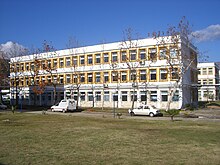
Ulcinj is connected with the rest of Montenegro by a two-lane highway. It is connected with other coastal towns by the
As of today, there are no airports in the city of Ulcinj. However, nearby airports in Tivat and Podgorica are both around 70 km (43 mi) away. There are regular flights to Belgrade and Zürich from Tivat. Podgorica Airport has regular flights to major Europe and destinations throughout the year. Many tourists traveling to Ulcinj from abroad arrive to the city from the airport in Tivat due to its recent renovations and general ease of navigation. There are also intercity buses that connect to other towns in the country and buses that go to Serbia, Albania, Northern Macedonia, Greece, and Germany (during tourist seasons) as well Flex bus operates in this area connecting to Bana Luka (Bosnia) and Dubrovnik.
International relations
Ulcinj is a founding member of the Union of Albanian Municipalities in the Region.[31][32] Ulcinj is twinned with:[33]
 Berat, Albania
Berat, Albania Deçan, Kosovo[34]
Deçan, Kosovo[34] Liesing (Vienna), Austria
Liesing (Vienna), Austria Lukavac, Bosnia and Herzegovina[35]
Lukavac, Bosnia and Herzegovina[35] Serik, Turkey[36]
Serik, Turkey[36] Stari Grad (Sarajevo), Bosnia and Herzegovina
Stari Grad (Sarajevo), Bosnia and Herzegovina Staten Island, USA[37]
Staten Island, USA[37] Uzhhorod, Ukraine
Uzhhorod, Ukraine
Cooperation and friendship
Ulcinj also cooperates with:
 Durrës, Albania
Durrës, Albania
Notable people
- Zeta from 1385 to 1403, member of the Balšić noble family.
- Dritan Abazović, prime minister of Montenegro
- Jelena Balšić, daughter of Lazar of Serbia, author of Gorički zbornik, first woman writer in South Slavs
- Gjon Buzuku, Catholic priest who wrote the first known printed book in Albanian
- Pjetër Gjoka, actor and People's Artist of Albania
- Rizo Šurla, photographer, and actor of African descent
- John VIII or Giovanni Bruni, archbishop of Bar (1551–1571)
- Adrian Lulgjuraj, Montenegrin-Albanian singer
- Alex Rudaj, Albanian-American mobster
- Lika Ceni, Captain and Pirate Commander
- Rade Tovladijac, Serbian comic book artist
- Mark Gjonaj, Albanian-American politician
- Mujo Ulqinaku, Albanian officer and a People's Hero of Albania
- Sabbateanmovement
- Andrej Nikolaidis, writer
- Cafo Beg Ulqini, Leader of Second League of Prizren and Knight of the Order of Skandebeg[38]
- Božidar Đurašković, athlete
- Vladimir Mihailović, basketball player
- Gazmend Çitaku is an Albanian Montenegrin photographer, publisher, and librarian
Bibliography
References
- ^ "Visit Ulcinj". Inspire your travels - latest. 18 February 2018. Retrieved 2021-06-18.
- ^ "Statistical Office of Montenegro". MONSTAT. Retrieved 2021-06-18.
- ^ "Ulcinj". Discover Montenegro. 2016-04-20. Retrieved 2021-06-18.
- ^ "The Ulcinj pirates – TO Ulcinj". TO Ulcinj – Welcome to TO Ulcinj. Retrieved 2021-06-18.
- ^ "Ulcinj in Middle Age – TO Ulcinj". TO Ulcinj – Welcome to TO Ulcinj. 2018-11-10. Retrieved 2023-05-09.
- ^ "Sabbatai Zevi – TO Ulcinj". TO Ulcinj – Welcome to TO Ulcinj. 2023-04-19. Retrieved 2023-05-09.
- ^ "The History of Ulcinj". Visit Montenegro. Retrieved 2021-06-18.
- ^ Čoralić, Lovorka (2011). "Verita d'alcuni heretici": The archbishop of Bar vs the count of Ulcinj - Two accusations, two testimonies (the sixteenth century)". Acta Histriae. 19 (3): 407–418.
- ^ "Ulcinj". My Guide Montenegro. Retrieved 2021-06-18.
- ^ "Ulcinj travel - Montenegro, Europe". Lonely Planet. 2019-09-08. Retrieved 2021-06-18.
- ^ "Montenegro - People". Encyclopedia Britannica. Retrieved 2021-06-18.
- ^ Pavle Mijović (1970). Tragom drevnih kultura Crne Gore. Grafički zavod. p. 35.
- ^ ISBN 978-5-87379-103-3.
- ^ "16". Claudii Ptolemaei Geographia edidit Carolus Fridericus Augustus Nobbe. Vol. 1. sumptibus et typis Caroli Tauchnitii. 1843. p. 134.
- ISBN 9780631146711. "Names of individuals peoples may have been formed in a similar fashion, Taulantii from ‘swallow’ (cf. the Albanian tallandushe) or Erchelei the ‘eel-men’ and Chelidoni the ‘snail-men’. The name of the Delmatae appears connected with the Albanian word for ‘sheep’ delmë) and the Dardanians with for ‘pear’ (dardhë). Some place names appear to have similar derivations, including Olcinium (Ulcinj from ‘wolf’ (ukas), although the ancients preferred a connection with Cholchis."
- ^ Birnbaum, Henrik; Puhvel, Jaan (1963). "The Position of Albanian". Ancient Indo-European Dialects. University of California Press. p. 108.
- ISBN 9004110240.
- ^ )
- ISBN 0-87169-248-1, page. 64
- ^ Paulucci, Luigi (2005). Le Bocche di Cattaro nel 1810 Edizioni Italo Svevo. Trieste.
{{cite book}}: CS1 maint: location missing publisher (link) - ^ Poláčková & Van Duin 2013, p. 80.
- ^ "Gazzetta Ufficiale del Regno d'Italia N. 261 del 6 Novembre 1918". Gazzetta Ufficiale del Regno d'Italia. 6 November 1918. Retrieved 5 May 2019.
- ^ LTKU (1989), fq. 46
- ^ Ćetković: DPS i Forca hoće da brišu istoriju Ulcinja
- ^ Ružna strana lepote Ulcinja
- ^ "Montenegro Census 2023". 2024-04-15.
- ^ Williams, Gisela (7 January 2010). "The 31 Places to Go in 2010: 24. Montenegro". New York Times.
- ^ Peel, M. C. et al Updated world map of the Köppen–Geiger climate classification. Hydrol. Earth Syst. Sci. 2007, Volume 11(1027–5606) pp1633–1644 DOI 10.5194 Hess-11-1633-2007.
- ^ "Climate: Bar" (in Montenegrin). Hydrological and Meteorological Service of Montenegro. Retrieved 6 March 2021.
- ^ "Dnevni prosjeci i ekstremi" (in Montenegrin). Hydrological and Meteorological Service of Montenegro. Retrieved 6 March 2021.
- ^ "Zyrtarizohet UBSHR, mbledh Konferencën e parë" (in Albanian). Unioni i Bashkive Shqiptare (UBSHR). 21 November 2016. Archived from the original on 2 October 2021. Retrieved 3 October 2021.
- ^ "Politikat Lokale – Bashk olitikat Lokale – Bashkëpunimi Ndërkomunal në K ëpunimi Ndërkomunal në Kosovë" (in Albanian). University for Business and Technology (UBT). p. 42. Archived from the original on 12 August 2021. Retrieved 3 October 2021.
- ^ "Bratimljenje" (PDF). database.uom.me (in Montenegrin). Zajednica opština Crne Gore. January 2013. p. 53. Retrieved 2021-07-07.
- ^ "Vendim për binjakëzimin e Komunës së Decanit me Komunën e Ulqinit" [Decision on the twinning of the Municipality of Decani with the Municipality of Ulcinj] (PDF) (in Albanian). Deçan Municipality. 31 July 2015.
- ^ ""Bratimljenje" Lukavca i Ulcinja od posebne važnosti za privrednu saradnju". opcina.lukavac.ba (in Bosnian). Lukavac. 2015-05-12. Retrieved 2021-07-07.
- ^ "Ceremonia në Serik: Nënshkruhet protokolli për binjakëzim". ul-info.com (in Albanian). UL Info. 2014-09-05. Retrieved 2021-07-07.
- ^ Porpora, Tracey (3 February 2024). "Did you know Staten Island now has a sister city across the globe?". New Haven Independent. Retrieved 5 February 2024.
- ^ "Nishani dekoron Cafo Beg Ulqinin me Titullin "Kalorës i Urdhrit të Skënderbeut" - Video". 20 April 2016.
Sources
- Poláčková, Zuzana; Van Duin, Peter (2013). "Montenegro Old and New: History, Politics, Culture, and the People" (PDF). Studia Politica Slovaca. VI (1).

